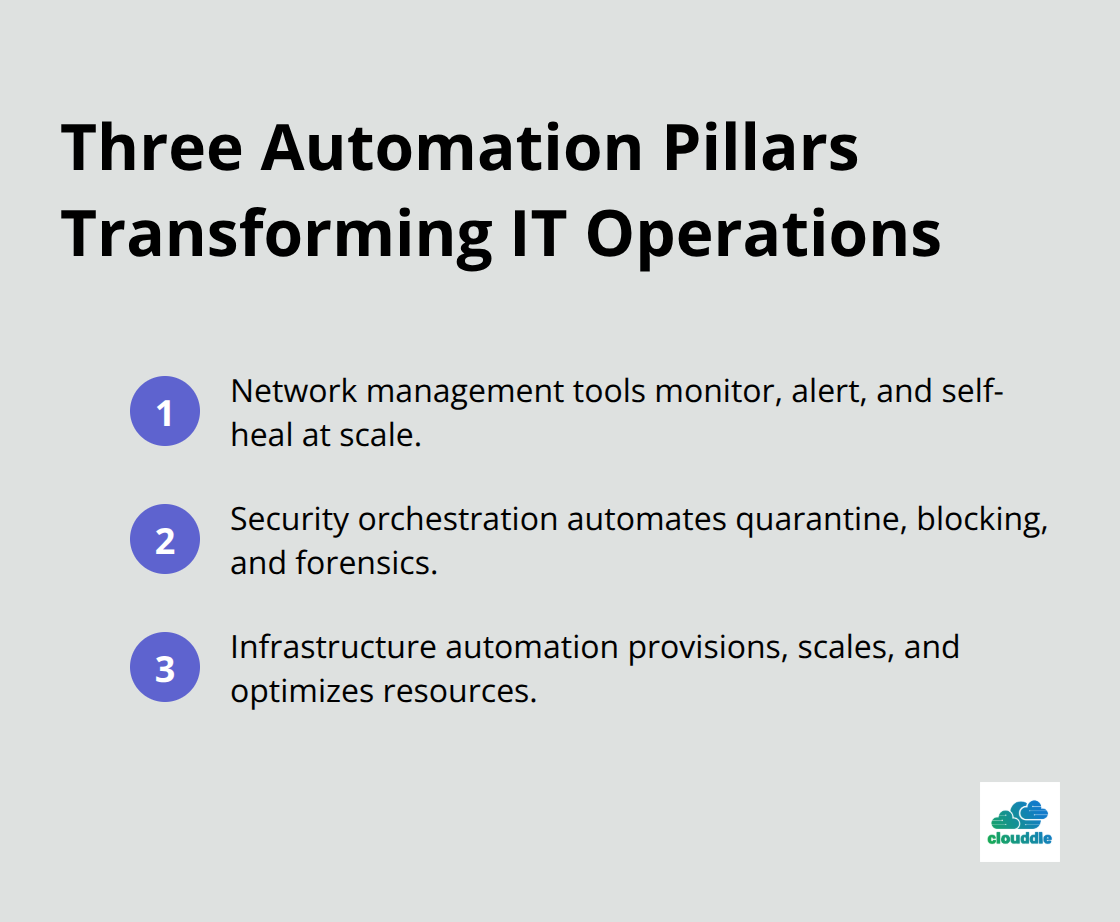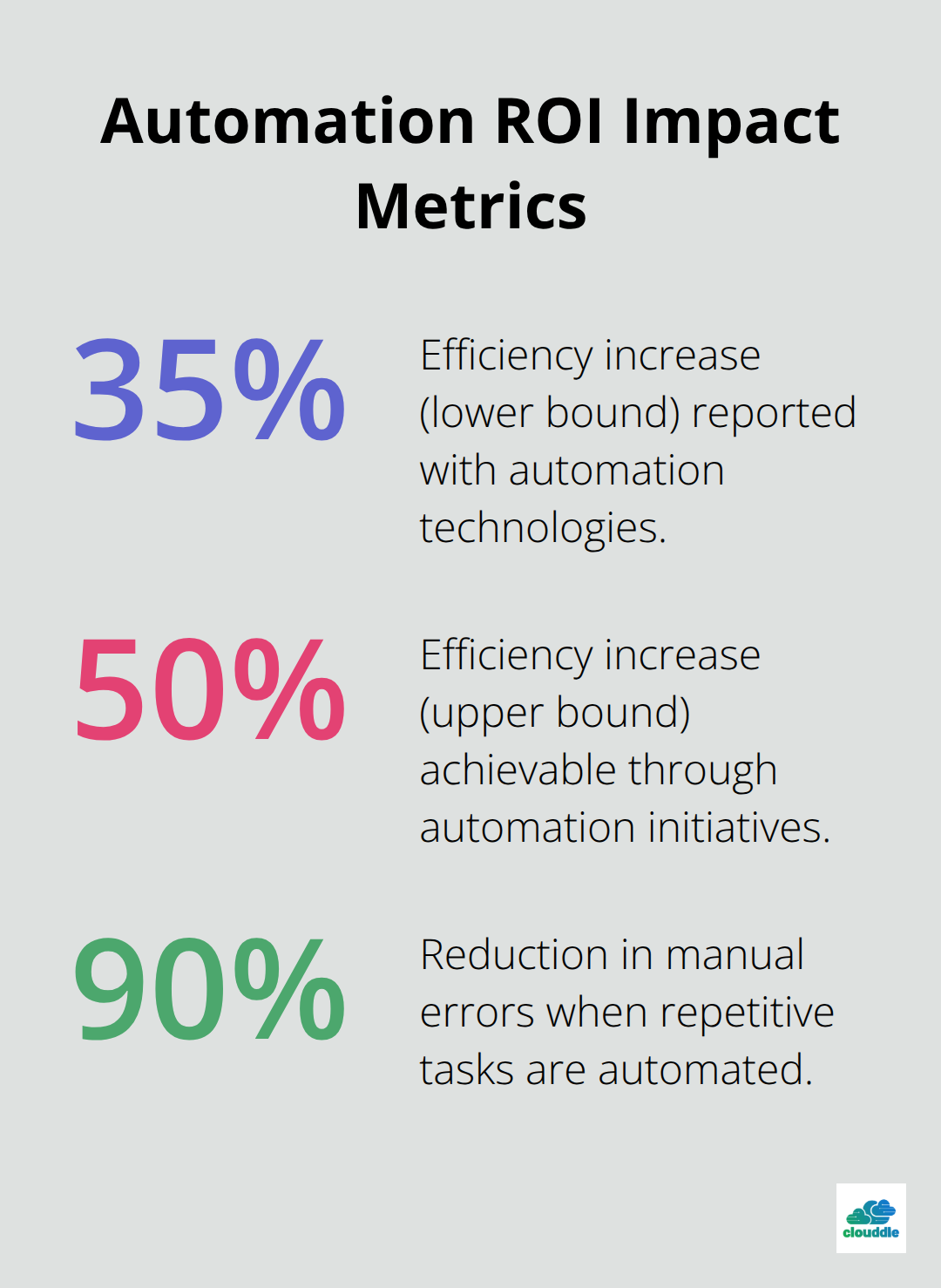Modern businesses face mounting pressure to streamline operations while managing complex IT environments. Manual processes drain resources and create bottlenecks that slow growth.
IT process automation solutions transform how organizations handle routine tasks, from network monitoring to security responses. We at Clouddle see companies reduce operational overhead by 40-60% through strategic automation implementation.
What Automation Solutions Transform IT Operations
Network Management Eliminates Manual Oversight
Network monitoring tools like SolarWinds and PRTG remove guesswork from infrastructure management. These platforms track bandwidth usage, device performance, and system health across thousands of endpoints simultaneously. Alert systems activate within seconds when thresholds breach normal parameters, while self-healing capabilities resolve common network issues without human intervention.

Configuration management tools such as Ansible and Puppet deploy updates across entire server farms in minutes rather than hours. Workflow automation significantly reduces time spent on repetitive tasks according to McKinsey research.
Security Response Automation Stops Threats Faster
Security orchestration platforms like Phantom and Demisto transform incident response from reactive firefighting to proactive defense. These systems automatically quarantine suspicious files, block malicious IP addresses, and initiate forensic data collection within milliseconds of threat detection.
Patch management systems from Microsoft WSUS and Red Hat Satellite push critical security updates to thousands of machines overnight. Breaches with identification and containment times under 200 days cost organizations $3.93 million, while those over 200 days cost $4.95 million.
Infrastructure Automation Scales Operations Instantly
Cloud orchestration tools like Terraform and AWS CloudFormation provision entire server environments through code-based templates. Container management platforms such as Kubernetes automatically scale applications based on demand, creating new instances when traffic spikes and shutting them down during quiet periods.
Database automation tools handle backup schedules, performance tuning, and failover procedures without administrator oversight. Forrester analysis indicates that infrastructure automation reduces provisioning time from weeks to hours while cutting operational expenses by 60% through optimal resource allocation.
These automation capabilities create the foundation for strategic implementation, but success depends on how organizations approach the transition from manual to automated processes.
How to Build Your IT Automation Strategy
Start with a comprehensive audit of your current IT workflows to identify bottlenecks and manual tasks that consume the most time. Document every process from ticket creation to resolution, measure average completion times and error rates. Focus on repetitive tasks that occur daily like server checks, backup verification, and user access setup. Organizations are increasingly adopting AI-based forecasting technologies, with 70% of large-scale organizations expected to implement these solutions by 2030.

Map dependencies between systems and highlight processes where delays create problems across departments.
Choose Tools That Integrate With Your Existing Systems
Select automation platforms based on your specific infrastructure rather than popular trends. Microsoft environments benefit most from PowerShell and System Center, while Linux-heavy organizations should prioritize Ansible or Chef. Evaluate how well tools connect with your current ticketing system, network monitoring tools, and security platforms. Test pilot programs with 2-3 processes before you commit to enterprise-wide deployment.
SolarWinds automation works well for network-heavy environments, while ServiceNow excels in ITSM automation. Calculate total cost of ownership over three years (including licenses, training, and maintenance) rather than focus solely on initial purchase price.
Train Teams Before Technology Deployment
Begin change management six weeks before automation rollout to address employee concerns about job security. Create hands-on labs where staff can experiment with new tools without effects on production systems. Establish automation champions within each team who receive advanced training and support colleagues during transition.
Track adoption metrics like tool usage rates and process completion times to identify gaps in knowledge. Companies with structured change management programs demonstrate meaningful correlation between dedicated resources and overall effectiveness. Schedule regular feedback sessions to adjust workflows based on user experience.
These strategic foundations prepare organizations to measure the tangible benefits that automation delivers across operations, costs, and service quality while helping reduce operational costs through improved efficiency.
What ROI Can You Expect From IT Automation
IT process automation delivers measurable financial returns within the first year of implementation. Organizations typically see productivity growth increases through automation technologies, with efficiency increases of 35-50%. Manual error rates drop by up to 90% when repetitive tasks shift to automated systems.

This eliminates costly mistakes in data entry, configuration changes, and security responses. Labor costs decrease significantly as teams redirect focus from routine maintenance to strategic initiatives that drive business growth. Forrester data shows companies achieve ROI above 300% within six months through reduced operational overhead and improved productivity metrics.
Response Times Transform Service Quality
Automated incident response systems resolve 80% of common IT issues within minutes rather than hours through predefined workflows and self-healing capabilities. ServiceNow reports that organizations reduce average ticket resolution time from 4.2 hours to 45 minutes with automation. Network monitoring tools detect and address performance issues before users notice problems. This maintains 99.9% uptime compared to 95-97% with manual monitoring approaches. Database automation handles backup verification, performance tuning, and failover procedures in seconds. This prevents extended downtime that costs enterprises $5,600 per minute (according to Gartner analysis).
Security Automation Strengthens Compliance
Security orchestration platforms automatically generate audit trails, document policy compliance, and track access changes across all systems. Patch management automation maintains security standards through rapid deployment of critical updates within hours of release rather than weeks through manual processes. Automated vulnerability scanning identifies and prioritizes security gaps based on risk severity, while compliance reporting tools generate real-time dashboards for regulatory audits. Organizations that use security automation experience 65% fewer successful breaches and reduce compliance preparation time from weeks to days.
Final Thoughts
IT process automation solutions represent a fundamental shift in how modern businesses operate their technology infrastructure. Organizations that implement these systems achieve 40-75% cost reductions while improving operational efficiency by 35-50%. The evidence shows clear financial benefits with ROI exceeding 300% within six months of deployment.
The automation landscape continues to evolve rapidly. Enterprises will automate over half of their network activities within the next two years, up from just 10% in 2023. AI integration within automation platforms will handle increasingly complex decision-making processes, while no-code solutions make these technologies accessible to organizations without extensive technical expertise.
Success requires strategic planning rather than rushed implementation. Start with comprehensive process audits, select tools that integrate with existing systems, and invest heavily in team training. We at Clouddle help businesses navigate this transformation through comprehensive technology solutions that combine networking, security, and managed IT services.


